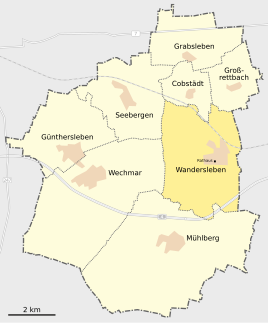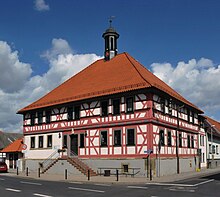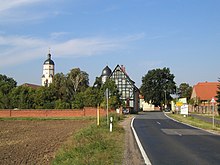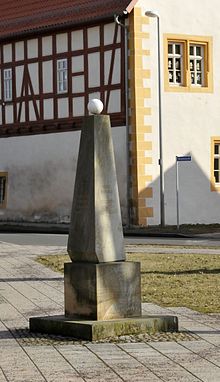Hiking life
|
Hiking life
Rural Community Three Equals
|
|
|---|---|
| Coordinates: 50 ° 53 ′ 50 ″ N , 10 ° 50 ′ 59 ″ E | |
| Height : | 266 m above sea level NN |
| Area : | 12.63 km² |
| Residents : | 1585 (Oct. 5, 2015) |
| Population density : | 125 inhabitants / km² |
| Incorporation : | January 1, 2009 |
| Postal code : | 99869 |
| Area code : | 036202 |
|
Location of Wandersleben in Drei Gleichen
|
|
Wandersleben is a village in the eastern district of Gotha in Thuringia . Since January 1, 2009, the formerly independent municipality has been part of the rural municipality of Drei Gleichen . The seat of the community is in Wandersleben. The district had 1649 inhabitants on December 31, 2010 on an area of 12.63 km².
Gleichen Castle is two kilometers south of Wandersleben .
Geographical location
Wandersleben is located in the Apfelstädt river valley at an altitude of 270 m above sea level. NN almost in the middle of the triangle Gotha - Erfurt - Arnstadt . The parts of the municipality separated by the river are connected by two bridges (one of which is only for pedestrians). Near the train station, the red water flows out at a height of 258 m above sea level. NN in the apple city.
Wandersleben has good transport links via the A4 motorway junction and via a stop on the Thuringian Railway in the Gotha – Erfurt section. The Thuringian City Chain Cycle Route runs through the village and leads from Creuzburg in the west via Erfurt to Altenburg in the east.
Wandersleben is a popular starting point for hikes to the Drei Gleichen .
history
Wandersleben is first mentioned in a document as Wantesleiben or Wantesleibo in a list of donations from the Fulda Monastery , which contains donations from the years 780 to 817. The history of the community has long been determined by the nearby Gleichen Castle . From the middle of the 10th century until they died out in 1631, the Counts of Gleichen had their seat here. The Hatzfelder were the successors for this part of the Grafschaft Gleichen until this family also died out in 1793. Wandersleben and Gleichen Castle fell back to Kurmainz and were placed under a separate administrator. In 1802 Wandersleben became Prussian . After the French occupation, the place with the neighboring former Mainz-Erfurt office Mühlberg became part of the Prussian administrative district of Erfurt ( district of Erfurt ) as an exclave .
After the Thuringian Railway had passed Wandersleben since 1847, the town received its own train station in 1885. A large estate in Wandersleben was the domain that belonged to the Duke of Saxe-Coburg and Gotha. It was also teaching material. In April 1945 the site was occupied by US troops and, like all of Thuringia, passed on to the Red Army at the beginning of July .
With the reorganization of the state in 1945, Wandersleben came to the state of Thuringia and has been part of the Gotha district ever since. In 1952, this part of the newly formed Erfurt district , which existed until the state of Thuringia was re-established in 1990. On May 21, 1992, the community merged with the neighboring communities of Grabsleben , Mühlberg and Seebergen to form the Drei Gleichen administrative community. From this merger, on January 1, 2009, the community of Drei Gleichen was created.
On the night of August 10-11, 2005, a major fire destroyed the town's shopping center down to the walls. The local volunteer fire brigade , which has its fire station 50 meters away, was only able to control the fire and prevent it from spreading to other buildings, despite the support of the fire brigades in the surrounding areas. The newly built shopping center opened on November 23, 2006.
Population development
(Figures refer to December 31 of the year specified)
|
politics
Since the re-establishment of the state of Thuringia in 1990, the conservative parties in town have received a high proportion of votes. In the last local election before the dissolution of the municipality in June 2004, the CDU had received 47.1% of the votes, a free voter group 33.7% and the SPD 19.2%. The last mayor since 1998 was Gerhard Päselt (CDU), who after the merger to the community of Drei Gleichen also held the office of local mayor until the district mayor election in 2014. In the last district mayor election in 2014, Sven Dahmen (FWG) received 42.0%, Gerhard Päselt (CDU) 41.5% and Dieter Honauer (SPD) 16.5% of the votes cast. Since none of the applicants received more than half of the valid votes cast, there was a runoff. This was decided by Sven Dahmen (FWG) with 57.8%.
coat of arms
Blazon : "In gold, a hiker in natural colors with a silver shirt, blue jacket with red collar and red socks with gold decorations, the lower buttons open, red breeches and stockings, black shoes and a black hat, a black roll diagonally across the back ( Blanket), in the right a black stick with a silver tassel, in the left a black glove. "
Above the entrance door of the town hall there is a relief stone with the year 1721, which represents a wanderer; We have also found the wanderer in the seal since the 18th century. The Wandersmann stands for the numerous visitors who visit Wandersleben and its wonderful surroundings. The gold of the escutcheon embodies the sun and the grain fields of late summer, which largely characterize the landscape. The wanderer wears a traditional costume that was common at that time and in this area and has been handed down as a symbol of the village seal since 1721.
The coat of arms was approved on August 14, 1998 and designed by Horst Baumgart from Wandersleben.
Culture and sights
See also: List of cultural monuments in Drei Gleichen (municipality)
Museums
Since September 2005, an exhibition on the life and work of the formerly famous Christian Friedrich Hunold alias Menantes has been available in the Menantes literary memorial. It was created in a renovated stable building in the rectory.
The museum is a protected cultural monument in the municipality of Drei Gleichen.
The history and local history association Wandersleben has set up a small local museum at the medieval residential tower. In the rooms of the servants' house, visitors can experience the village life of bygone times.
Buildings
Castle Gleichen
→ Main article: Castle Gleichen
The castle Gleichen (also Wanderslebener Gleiche , Wandersleber Castle , Wandersleben Castle ) is a medieval castle ruin . It belongs to the castles ensemble of the three equals .
Medieval residential tower
The residential tower of migrant life was built around 1250 as part of a manor house and belonged including large estates the sex of scenting . After the manor was burned down in 1450, the residential tower was incorporated into a new large building, a four-sided courtyard, in 1599 . In 1636 he went as a fief to those of Volgstedt . Until 1975 the building had constantly changing owners when it passed into the ownership of the municipality.
Since 1979 the building had been dilapidated and uninhabited. In 1983 the half-timbered building was demolished because it was dilapidated and the residential tower was rediscovered. Due to the protective renovation, the residential tower was hardly exposed to environmental influences for a long time and is therefore well preserved. After the discovery, a community of interests called "Medieval residential tower" quickly came together to develop the early Gothic residential tower.
The history and homeland association Wandersleben 2005 e. V. the object. Since then there has been regular support and redesign. In September 2010, the redesign could be continued with the handover of the reconstructed servants house, in which club rooms for small events and a small museum were set up.
The entire area around the medieval residential tower - a former four-sided courtyard - offers a variety of objects that could be seen on a farm. With the redesign of the courtyard at the residential tower between 2008 and 2010, half of the front building, which was no longer available, was rebuilt. The history and local history association Wandersleben 2005 e. V. set up rooms in it as a small local museum. On the lower floor you can see a copy of the cartular with the first mention of the place, historical maps and photos. In the former small court kitchen and on the upper floor, furniture, household items and household items from a farm from bygone times, which were left by residents and visitors, are shown.
St. Petri Church
→ Main article: The Church of St. Petri
The originally Romanesque church stands on the outskirts in the direction of Apfelstädt .
Waid and other mills
In the far west of the Wandersleben district, about 1.5 km away in the direction of Seebergen, stood the Waidmühle , which was destroyed by arson in early 2000 and then completely demolished. It is the last of three mills that were operated in the immediate vicinity of the Apfelstädt, but not with the water from the Apfelstädt, but with that of the Mühlgraben, which comes from Günthersleben and about 1000 m away upstream the Mittel- and Obermühle ( "Weidmühle", formerly "Mühle unter den Weiden", in the Seeberger area) fed with water. It flowed from about Obermühle parallel to the Apfelstädt. The trench has been largely dry since the late 1950s. Obermühle and Mittelmühle date from 1299 and are the oldest mills along the 20 km long Apfelstädt-Mühlen nature trail for explorers between Schwabhausen and Marienthal near the Apfelstädt confluence with the Gera.
The mills were mentioned in a document as early as 1299 as a gift from the Count of Orlamünde to the Stadtilm monastery. In a feudal letter from Count Adolf and Siegmund von Gleichen from 1436, a mill is named "to Seebergen zu". Over the centuries, the owners and operators changed frequently, with nine operators in the 18th century alone.
The ownership and operator relationships have been documented almost completely since 1621:
- In 1621, the council and chamber secretary Sigismund Heussner bought the mill from Count Hans Ludwig von Gleichen († 1631).
- In 1713 Countess Anna Elisabeth zu Gleichen and Hatzberg sold the mill to the Seeberger Hans Sebastian Schröter.
- After Schröter's death in 1715, the widow Hans Müller married.
- Heinrich Kritzmann leases the mill from 1718 to 1722 from the Müller / Schröter community of heirs.
- 1730 son Hans Christoph Schröter bought his share of the property from the community of heirs.
- HC Schröter dies in 1738, the child guardian takes over the lease
- In 1741 Otto Sylvester Krantz leases the woad and oil mill
- In 1746 Heinrich Ballstädt, orphanage inspector in Gotha, bought the mill for 2,400 guilders for the underage Bebe siblings
- In 1750 Johann Caspar Schlegelmilch became the tenant, followed by him
- 1755 Johann Zacharias Schlegelmilch.
- In 1764 the municipality of Wandersleben bought the mill for 3500 guilders , but without a feudal permit, so it became
- 1765 resold to Christian Heinrich Krumbholz from Wandersleben. He leases them
- 1769 to Johann Andreas Gläser.
- In 1784 the prince acquires . Saxon. Gothaer Rath and librarian HAO Reichardt die mill.
- In 1787 the property was given to the Nottleber Nicolaus Leonhardt for 2070 guilders.
- In 1793 the mill had three grinding courses and one oil course and was sold to Balthasar Stötzer from Schönau vor dem Walde . Purchase price 2300 guilders.
- In 1811 negotiations begin with the responsible Prussian authorities about the replacement of the inheritance payments .
- Stötzer dies in 1826 and leaves the property to his daughters. Johanna Magdalena Stängel, b. Stötzer, her sister Martha Elisabeth pays off and continues to run the mill until
- 1836 the feudal lordship passes into the jurisdiction of the Gotha ducal house.
- In 1845 the Stengels go into debt, it comes afterwards
- 1850 for the court hearing and the forced sale to the privy councilor Johann Friedrich von Weißenborn from Erfurt and
- 1851 for sale to Johann Michael Hopfe and his sister. In the same year there is the first date of a foreclosure auction on a mill with three grinding courses and an oil mill.
- In 1853, the master miller Christian Friedrich Hesse from Wandersleben bought the mill for 4,000 thalers , took over the inheritance from the mill and leased the mill.
- In 1860 Johann Conrad Stängel, the son of the former tenant, leased the mill, however
- In 1869 it was sold again by Hesse to the ducal property administration.
- In 1889 the miller Gustav Demuth is the tenant, whose family, through Franz and Erich Demuth, remain Waidmüller until 1960.
- In 1947 the mill was attacked overnight by marauding soldiers of the Soviet occupation forces.
- In 1959 the water supply is permanently interrupted by the flood-related destruction of the Wechmar weir. The grinding operation is stopped.
Below the Waidmühle there was the "Stedekorn paper mill" on the same ditch from 1721 to 1871. Stedekorn (father and son) were formerly tenants of the "Hunold'sche paper mill" (today Wechmarer Straße 21b). The Waidmühle was used as a residential building until 1969. The other two mills are currently being used as residential buildings, and there is no longer a mill.
More Attractions
- Relief stone above the entrance door of the town hall from 1721
- wrought iron representation of the wanderer from 1800 on the town hall
- stone plaque with inscription 1541 on the half-timbered house at Menantesstrasse 13
- medieval stone crosses on the footpath to Gleichen Castle
- Henningshof (opposite the town hall), residential building from the 16th century, today a conference and exhibition center
- On the Stangenweg, clay disc wheels with hubs were found in the ground at a depth of 40 cm. A comparable find was made in the Danube region. These finds indicate the importance of the wheel in the early Bronze Age , although they may still have cultic or symbolic significance.
- On the hill Galgenberg or Galgenhög ( ⊙ ) there is a burial mound from which Neolithic and Bronze Age finds were recovered. About a kilometer further east is another burial mound from which finds from prehistoric times have also been recovered.
Regular events
Wandering is the goal of the annual Thuringian Castle Tour , in which more than 10,000 cyclists regularly take part. According to the organizers, this is the largest bicycle rally in the world, although it should be noted that the Berlin bicycle rally with over 100,000 participants attracts significantly more cyclists.
Every year on the third weekend in September, the Wandersleben farmers' market has been held for over 30 years. Here, articles from the region are offered, the kindergarten, the Wandersleben carnival club, the Wandersleben spinning room and other clubs provide atmosphere and entertainment, grain was threshed with Lanz technology and much more.
The last weekend in May is traditionally at the medieval residential tower for all those who are interested in history and culture at the same time.
economy
Between Wandersleben and the Autobahn, huge halls for laying hens were built in the 1970s for a "fresh eggs combine" of LPG Wandersleben, which significantly impaired the Drei Gleichen landscape. In the meantime they are no longer so noticeable due to the surrounding tree growth. The systems were taken over by the Sachsen-Ei company after the fall of the Wall.
In 2013 an "organic pig fattening facility" was to be built on the outskirts. The population of Wandersleben joined together in a citizens' initiative in 2012 and was able to prevent construction.
At Glas-Cycle , important secondary raw materials for the glass and metal industry are obtained.
Personalities
- Christian Friedrich Hunold (* 1680; † 1721) famous novelist and poet of the first half of the 18th century who published under the synonym "Menantes".
- Johann Stephan Schmaltz (* 1715; † 1784), organ builder and student of Johann Christoph Thielemann
- Christian Steffani (* 1780; † 1846), Protestant theologian
- Karl Mey (* 1879; † after May 1945), German industrial physicist and from 1933 to 1935 chairman of the German Physical Society (DPG)
- Walther Heinze (born February 19, 1888 in Tiefthal near Erfurt, † June 19, 1971 in Wandersleben) teacher and cantor in Wandersleben, author of writings from the Drei Gleichen area. Author of the book: From the area of the three equal wandering lives - A home book
Pictures from hiking life
- The apple city
- building
Painting on the house wall at the kindergarten (" Dreikäsehoch ")
Stone tablet with the year 1541, the upper writing means V erbum D omini m anet in Ae ternum. Including IHS , the Christ monogram.
societies
- Boxing club
- Volunteer firefighter
- Football club
- Carnival club
- Bowling club
- Fair club
- Equestrian Club
- Shooting club
- Spinning room
- Table tennis club
- Allotment Association
- History and local history association Wandersleben 2005 e. V.
Trivia
The Wanderslebener call themselves and by the inhabitants of neighboring communities Sand Ride- called, perhaps because they in the valley of Apfelstädt There, with the abundant sand Siedel (ed).
Individual evidence
- ↑ StBA: Area changes on 01/01/2009
- ^ Thuringian State Office for Statistics; State Returning Officer
- ↑ Information board near the former Waidmühle
- ↑ Michael Köhler: Pagan sanctuaries. Jenzig-Verlag, 2007, ISBN 978-3-910141-85-8 , pp. 249/250.
- ↑ Michael Köhler: Pagan sanctuaries. Jenzig-Verlag, 2007, ISBN 978-3-910141-85-8 , p. 135.
- ↑ http://bi-gs3g.de/
- ^ Albert Schumann: Steffani, Christian . In: Allgemeine Deutsche Biographie (ADB). Volume 35, Duncker & Humblot, Leipzig 1893, p. 553 f.






















